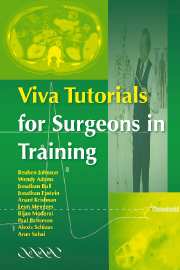3 - Applied Physiology
Published online by Cambridge University Press: 12 August 2009
Summary
CELLULAR PHYSIOLOGY
Membranes
What is the main function of the cell membrane?
To control the entry and exit of molecules from the cell and so regulate the intracellular environment.
Describe the basic structure of a cell membrane.
The cell membrane consists of a continuous lipid bilayer studded with protein molecules.
How does this structure allow control of the movement of molecules into and out of the cell?
The lipid bilayer has hydrophilic groups facing outwards while hydrophobic groups face each other across the middle. Most large water-soluble molecules, charged molecules and ions cannot cross the lipid barrier. Size, charge and water-solubility all decrease the ability of a molecule crossing the fatty membrane. These substances depend on the membrane proteins for their entry and exit from the cell. These proteins can act as channels sensitive to voltage or ligandbinding or as energy-dependent pumps. Fat-soluble substances like oxygen and carbon dioxide can cross easily as can water.
What is the overall charge of the outer surface of the cell membrane?
Negative.
What part of the membrane structure is responsible for this negative charge?
The cell has a “glycocalyx” formed by membrane carbohydrates, which are negatively charged. These carbohydrates also act as receptor substrates and can bind to carbohydrates on other cells.
Ion Channels
What is the basic structure of an ion channel?
They are proteins, which form tubular structures with a central pore which traverses the cell membrane and can allow communication between the extracellular fluid and the intracellular compartment.
- Type
- Chapter
- Information
- Viva Tutorials for Surgeons in Training , pp. 97 - 142Publisher: Cambridge University PressPrint publication year: 2004



